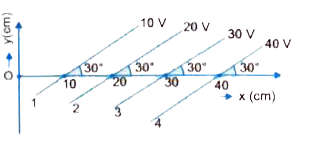Why are electric field lines perpendicular at a point on an equipotential surface of a conductor ?
On equipotential surface ΔV=0 As ΔV=→E.Δ→r, So →E is perpendicular to Δ→r
Topper's Solved these Questions
Similar Questions
On the basis of your understanding of the following paragraph and the related studied concepts.
An equipotential surface is a surface with a constant value of electric potential at all points on the surface. The component of electric field parallel to an equipotential surface is zero, as the potential does not change in this direction. Thus, the electric field is perpendicular to the equipotential surface at each point of the surface. Further, say the direction of electric field electrical potential gradually fall with distance.
Draw equipotential surfaces around an isolated positive point charge + q. Mark direction of electric field →E also.View SolutionOn the basis of your understanding of the following paragraph and the related studied concepts.
An equipotential surface is a surface with a constant value of electric potential at all points on the surface. The component of electric field parallel to an equipotential surface is zero, as the potential does not change in this direction. Thus, the electric field is perpendicular to the equipotential surface at each point of the surface. Further, say the direction of electric field electrical potential gradually fall with distance.
Four equipotential surfaces are shown in the adjoining figure. Find the magnitude and direaction of the electric field.
 View Solution
View Solution
Knowledge Check
- Question 1 - Select One or More
P i sa point on an equipotential surface S. The field at P is E.
AE must be perpendicular to S in all cases .BE will be perpendicular to S only if S is a plane surface.CE canot have a component along a tangent to S.DE may have a nonzero component along a tangent to S if S is a curved surface. - Question 2 - Select One
The electric field lines coming out of an equipotential surface are
Aperpendicular to the surfaceBparallel to the surfaceCin all directionsDzero - Question 3 - Select One
STATEMENT -1 : the surface of a charged conductior is always equipotential .
STATEMENT -2 : Electic field lines are always perpendicular to the equipotential surface.AStatement -1 is True , Statement -2 is True ,
Statement -2 is a correct explanation for
Statement -2BStatement -1 is Tre , Statement -2 is True ,
Statement -2 is NOT a correct explanation for statement -1.CStatenebt -1 true, Statement -2 is Fakse.DStatement -1 is False , Statement -2 is true.
On the basis of your understanding of the following paragraph and the related studied concepts.
An equipotential surface is a surface with a constant value of electric potential at all points on the surface. The component of electric field parallel to an equipotential surface is zero, as the potential does not change in this direction. Thus, the electric field is perpendicular to the equipotential surface at each point of the surface. Further, say the direction of electric field electrical potential gradually fall with distance.
If a charge of 2 nC is taken from equipotential surface number 2 to 3, what is the amount of work done ?View SolutionOn the basis of your understanding of the following paragraph and the related studied concepts.
An equipotential surface is a surface with a constant value of electric potential at all points on the surface. The component of electric field parallel to an equipotential surface is zero, as the potential does not change in this direction. Thus, the electric field is perpendicular to the equipotential surface at each point of the surface. Further, say the direction of electric field electrical potential gradually fall with distance.
If electric potential at origin point O be 100 V, then for electric field specified in part (b), draw equipotential surfaces corresponding to potentials 80 V, 60 V and 40 V respectively.View SolutionOn the basis of your understanding of the following paragraph and the related studied concepts.
An equipotential surface is a surface with a constant value of electric potential at all points on the surface. The component of electric field parallel to an equipotential surface is zero, as the potential does not change in this direction. Thus, the electric field is perpendicular to the equipotential surface at each point of the surface. Further, say the direction of electric field electrical potential gradually fall with distance.
A uniform electric field →E=1000ˆiVm−1 exists in space at a given place. What is the shape of equipotential surfaces there ?View SolutionThe angle between the equipotential surface and the electric field (or line of force) at any point on the equipotential surface is
View SolutionEstablish the relation between electric field and electric potential at a point. Draw the equipotential surface for an electric field pointing in +Z direction with its magnitude increasing at constant rate along -Z direction
View Solution

